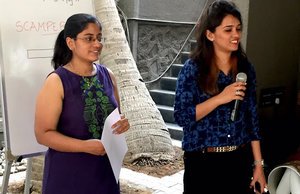Incident at a fort!
A moonless midsummer night of 1990 when we had our own tryst with destiny.
By ASHISH DESHPANDE
The year was 1989 for certain. Yet, it is unclear when Elephant1 started. No one is sure. Perhaps it was that Design Management module in our fourth year. It could have been one of those countless discussions that excitedly took place on the stair leading to the auditorium or those precious wasted hours at NID2 gate over Chai3. Maybe, a hard date can be inscribed as April 16th. 1989, the day pioneers of the herd landed in Pune with their trunks, hold all & drawing boards. Another date that probably is hard coded is 02 May 1989, date the firm got itself registered as Elephant and a working deed was drawn out by a bemused CA4, who wondered the point of making the deed when Design itself was questionable in his mind.
As fresh graduates, we saw the bleak landscape that Design in India presented as an opportunity. We were friendly, eager to learn, connect and people around were more than willing to help a fledging professional practice. Elephant survived, and a year later, excited, we plotted to celebrate our one-year of existence in the Indian design landscape. May, 01 1990 was pegged as Elephant Day, maybe it helped that 01st of May was a public holiday5 or in most probability, it was the most convenient average of various dates.
We finished working late on the 30th. April. Yes, we worked hard those days as we continue the tradition even today. The plan was to pick up five Chicken Tandoori 6 portions, half a dozen bottles of Pilsner beer, hire a Fiat Premier 7(big deal those days, since we has 2 scooters between the five) and head to Sinhagad 8, a 1400AD fort that towers over the city about 30 km from Pune.
The herd started from Pune at about 10:30 in the night. It was a lonely drive up the hill to the base of the fort. There was no one around and we hiked up the fort to find a great spot overlooking the city in the distance. The plan was to see the sunrise from the fort ramparts and celebrate our first year as Elephant.
We celebrated nonetheless, consuming beer, the chicken tandoori, and talked our way through the night. There was no good shelter and we were lying in the open on the wild grass looking at stars.
That night, at that moment, life taught us one of our first lessons. Around 3 am., as breeze grew stronger and a chill set in. It was difficult to remain in the open. We had come unprepared, there was no torch or matchstick and we were in our light summer Tees. By 3:30am, we were shivering. Rattling our way back to the parking lot, we woke up the cab driver and started our descent back to Pune. The driver, poor soul was obviously sleepy and lost control of the Fiat and the car scrapped against a Bund wall 9 over the valley below. The fiat lost its headlamp, side panel & trims and the driver lost his sleep. We were lucky to be alive.
We never saw the sunrise. I guess, Pune had acquired a new sun, for the next 28 years, all thanks to the lesson at the fort and our bone rattling experience. We got back and laughed. We laugh every year when this incident is remembered and how close we were to having no Elephant in any room at all.
The journey that began so carefree goes on and each year we remember the lessons learnt, adapt and shine on. The Design landscape has flowered and the herd has grown. However, what remain is that spirit, that took us on this carefree journey, and till this day, we get rattled, we learn, most importantly, we laugh and move on.
































